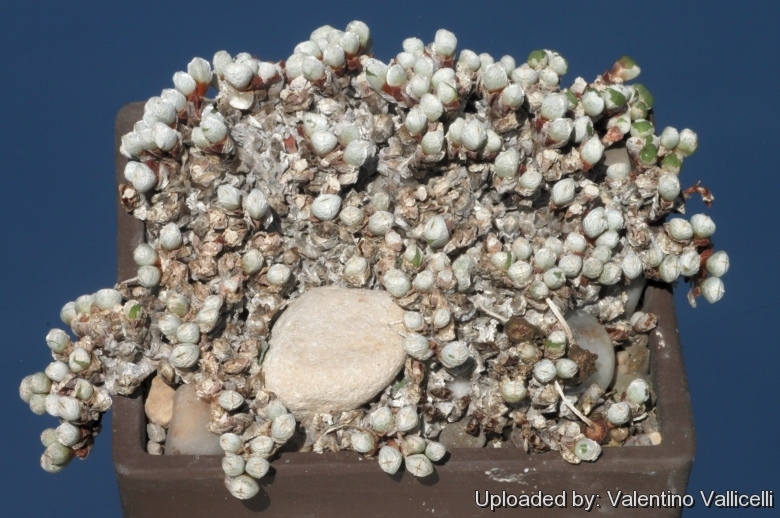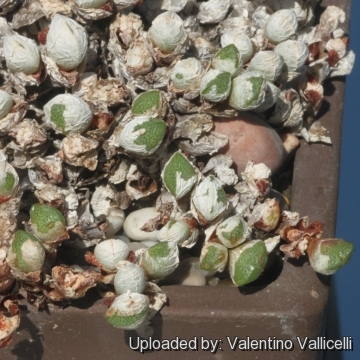
Cheiridopsis minor Photo by: Valentino Vallicelli
A very old specimen photografed duribg the resting phase. The entire plant sheaths over in summer heat.
Origin and Habitat: Namaqualand, Northern Cape, South Africa.
Altitude: Around 300 metres above sea level.
Habitat: Cheiridopsis minorSN|27082]]SN|27082]] grows in gravelly soils. Rainfall around 100 mm p.a. in winter or March and November. It is dormant in summer.
Synonyms:
See all synonyms of Cheiridopsis minor
back
Accepted name in llifle Database:Cheiridopsis minor (L. Bolus) H.E.K.HartmannIllustr. Handb. Succ. Pl.: Aizoaceae A-E (ed. H.E.K.Hartmann) A-E 123 2002 publ. 2001.Synonymy: 2
back
Common Names include:
RUSSIAN (Русский): Хейридопсис Мейера разн. маленькая
Description: Cheiridopsis minor also known as Cheiridopsis meyeriSN|27080]]SN|27080]] var. minor, is a compact, mat forming perennial-succulent plant less than 2 cm tall and 5-15 cm in diameter. It is highly branched with short visible internodes, and produces two different types of greenish-grey leaves, the smallest leaves in the genus. The resting pair are united, forming a Conophytum-like body and the pair produced in the growing season are separated. Entire plant sheaths over in summer heat.
Leaves: Markedly heterophyllous (dimorphic). Tiny rounded to clamshell-like, opposite, similar to those of Cheiridopsis meyeriSN|27080]]SN|27080]], but smaller: 6-9 mm long, and less than 4 mm across; dry leaf sheaths also basally brown. Short leaf-pair (or resting pair) connate forming a whitish, basally reddish-brown papery sheath during the dry season enclosing the long leaf-pair which is connate more than 40%, but leaf length almost equal. Keel with a line of long papillae, otherwise smooth and flat.
Flowers: Yellow.
Fruits: Decumbent, with a conspicuous turret-shaped top with a central dip, the covering membranes below with high pipes or wings in subapical position as in C. namaquensis;
Notes: This species along with Cheiridopsis meyeriSN|27080]]SN|27080]] and Cheiridopsis delphinoides is part of a group of strictly related species formerly considered as one. C. minor differs from C. meyeri by the possession of conspicuous pipes on the valve wings which raise the valves to a turret-shape, and by its much higher degree of branching.
Bibliography: Major references and further lectures
1) Heidrun E. K. Hartmann “Aizoaceae A – E” Springer, 2002
2) Debra Brown Folsom, Huntington Botanical Gardens “Dry climate gardening with succulents” Pantheon Books, 14/mar/1995
3) James Cullen, Sabina G. Knees, H. Suzanne Cubey “The European Garden Flora Flowering Plants: A Manual for the Identification of Plants Cultivated in Europe, Both Out-of-Doors and Under Glass” Cambridge University Press, 11/Aug/2011
4) Bot. Jahrb. Syst. 108: 567-663 (1986), 1987
5) Barkhuizen, B.P. “Succulents of Southern Africa.” Purnell, Cape Town 1978.
6) Hartmann, H.E.K. “Growth forms and leaves in the genus Cheiridopsis” N. E. Br. Cactus & Succulent Journal (U.S.) 60: 168–173. 1998
7) Le Roux, A. & Schelpe, E.A.C.L.E. 1997. Namaqualand . “South African Wild Flower Guide 1.” Botanical Society of SouthAfrica, Cape Town.
 Cheiridopsis minor Photo by: Valentino Vallicelli
Cheiridopsis minor Photo by: Valentino VallicelliSend a photo of this plant.The gallery now contains thousands of pictures, however it is possible to do even more. We are, of course, seeking photos of species not yet shown in the gallery but not only that, we are also looking for better pictures than those already present.
Read More... Cultivation and Propagation: Cheiridopsis minorSN|27082]]SN|27082]] is a "winter" grower which is most active from late winter until later spring and heading for summer dormancy . The growing season in northern hemisphere is from September to March. It is is relatively difficult to grow because rots easily. Paying attention to the particular growing requirement of Cheiridopsis minorSN|27082]]SN|27082]] is especially important. If you provide the plant with the right conditions, it will reward you with it unique shape and size. However, it is a tricky plant that is very particular about its growing conditions and require the right maintenance in order to keep happy. The plant is dormant and sheaths over in summer heat.
Soil: It grows best in sandy-gritty soil and requires good drainage as it it is prone to root rot. It can grows outdoor in sunny, dry, rock crevices (protection against winter wet is required).
Fertilization: It thrives in poor soils ans seems very sensitive to an excess of potassium.
Watering: Water minimally in summer. Water regularly in winter after the new long green leaves appears at their extremities in autumn after the summer resting period. Requires good drainage.
**Fertilization: Be careful not to apply too much fertilizer. Feed it once during the growing season with a fertilizer specifically formulated for cactus and succulents (poor in nitrogen), including all micro nutrients and trace elements diluted to ½ the strength recommended on the label. It thrives in poor soils and need a limited supplies of fertilizer to avoid the plants developing excess vegetation, which is easily attacked by fungal diseases.
Light: It needs a bright sunny or light shade exposure in winter, but keep cool and shaded in summer. Ensure a very good ventilation.
Hardiness: It prefer a very bright situation and will take a light frost (Hardy to -5°C) if it is in dry soil. USDA zones 9A – 11.
Repotting: Avoid to repot frequently. This plant may stay in the same pot for many years. Plants grown in larger containers have frequently relatively poor flowers. It might improve when the plants are given their own, small individual pots.
Pests and diseases: It is vulnerable to mealybugs and rarely scale.
Uses: Container, rock garden.
Propagation:*** Seeds, cuttings. It is relatively difficult to root it from cuttings and generally pointless as well, so quick are they from seed.












